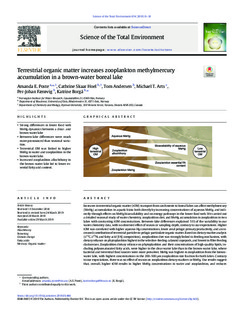| dc.description.abstract | Increases in terrestrial organic matter (tOM) transport from catchments to boreal lakes can affect methylmercury (MeHg) accumulation in aquatic biota both directly by increasing concentrations of aqueous MeHg, and indirectly through effects on MeHg bioavailability and on energy pathways in the lower food web. We carried out a detailed seasonal study of water chemistry, zooplankton diet, and MeHg accumulation in zooplankton in two lakes with contrasting tOM concentrations. Between-lake differences explained 51% of the variability in our water chemistry data, with no observed effect of season or sampling depth, contrary to our expectations. Higher tOM was correlated with higher aqueous Hg concentrations, lower areal pelagic primary productivity, and an increased contribution of terrestrial particles to pelagic particulate organic matter. Based on dietary marker analysis (δ13C, δ15N, and fatty acid [FA] composition), zooplankton diet was strongly linked to feeding mechanism, with dietary reliance on phytoplankton highest in the selective-feeding calanoid copepods, and lowest in filter feeding cladocerans. Zooplankton dietary reliance on phytoplankton and their concentrations of high-quality lipids, including polyunsaturated fatty acids, were higher in the clear-water lake than in the brown-water lake, where bacterial and terrestrial food sources were more prevalent. MeHg was highest in zooplankton from the brown-water lake, with highest concentrations in the 200–500 μm zooplankton size fraction for both lakes. Contrary to our expectations, there was no effect of season on zooplankton dietary markers or MeHg. Our results suggest that, overall, higher tOM results in higher MeHg concentrations in water and zooplankton, and reduces zooplankton dietary reliance on phytoplankton. Increased tOM thus leads to a decrease in the nutritional quality of zooplankton (i.e. higher MeHg concentrations, and lower concentrations of essential fatty acids), which may cascade up the food web with negative implications for higher trophic levels. | nb_NO |

